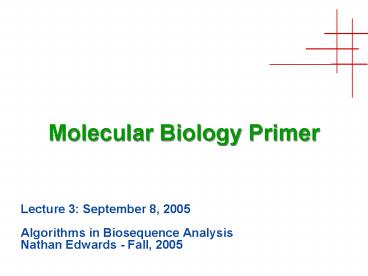Molecular Biology Primer - PowerPoint PPT Presentation
1 / 51
Title:
Molecular Biology Primer
Description:
Electrophoresis. Separate based on size and shape. Fluorescence ... 2D Gel-Electrophoresis. Protein separation. Molecular weight (Mw) Isoelectric point (pI) ... – PowerPoint PPT presentation
Number of Views:25
Avg rating:3.0/5.0
Title: Molecular Biology Primer
1
Molecular Biology Primer
- Lecture 3 September 8, 2005
- Algorithms in Biosequence Analysis
- Nathan Edwards - Fall, 2005
2
Biotechnology
- Use the machinery of molecular biology to study
- DNA
- Genes
- Transcription
- Splicing
- Proteins
- Polymorphism
- Coupled with samples to compare, we have systems
biology.
3
Biotechnology
- Use (abuse) specific proteins from biology to
manipulate the sample - Biochemistry techniques make the result
observable - Observation is digitized and (often) processed
for consumption
4
DNA Manipulation
- Restriction enzymes
- Cut DNA into smaller pieces
- Hybridization
- Join two complementary single stranded DNA
molecules - Polymerase Chain Reaction (PCR)
- Make lots of copies of a small DNA region
- Cloning / Vectors
- Make lots of copies of a large DNA region
5
Observation
- Electrophoresis
- Separate based on size and shape
- Fluorescence
- Brightness / Color
- Arrays
- Compact / Position determined
6
Restriction Enzymes
- Cut DNA at specific sequence motifs
- EcoRI
- EcoRII
- EcoNI
- IUPAC Symbols represent multiple possible bases
GAATT C C TTAAG
CCWGG GGWCC
CCTNNN NNAGG GGANN NNNTCC
7
IUPAC Amiguity Codes
- International Union of Pure and Applied Chemistry
8
DNA Denaturation Hybridization
9
DNA Denaturation Hybridization
- DNA will hybridize with any single DNA strand
with the correct (complementary) DNA sequence - Short oligonucleotides can hybridize to the DNA
strand instead!
10
Polymerase Chain Reaction
11
PCR
12
Cloning
- Result is a colony of bacteria that all contain
the inserted sequence. - The inserted sequence can later be extracted
using similar techniques - Suitable for larger pieces than PCR
13
Electrophoresis
14
Florescence / Dyes
- Add colors for optical detection
15
DNA Sequencing
- Similar to PCR, but only 1 primer
- A few special, labeled nucleotides terminate
extension - Get a random mix of different length fragments
color-coded by final nucleotide
16
DNA Sequencing
- Electrophoresis separates the fragments by size
17
DNA sequencing
18
DNA Sequencing
19
Genotypes
- Everybodys genome is essentially the same
- but the differences matter
- We each have two copies!
- Genomic variation
- may have a direct or indirect effect
- records heredity
- provides genomic landmarks
20
Genotyping Technology
Probes for each allele
Genomic DNA
SNP site
21
Genotyping Technology
Genomic DNA
SNP site
22
Genotyping Technology
Genomic DNA
SNP site
23
mRNA / Transcription
- Reverse transcriptase
- Makes a DNA copy of the mature RNA
- After introns are spliced out.
- cDNA complementary DNA
- cDNA can then be amplified by PCR, and sequenced
- All of the previous techniques can now be applied
to the cDNA - Sequencing ESTs
- Quantitation microarrays
24
Gene Expression
- Quantify the amount of gene expression
- Measure mRNA
- cDNA hybridization and fluorescence
- Many genes at once
- Usually compares two samples
- Treated, control
- Tumor, non-tumor
- Time course
- Lots of images from Terry Speeds website
25
Gene Expression
- Label samples
- Hybridize and scan
26
Gene Expression Data
27
Proteins
- Digestion enzymes
- Cuts proteins into pieces
- Separation by physical or chemical properties
- water affinity, mass, AA composition
- Cant amplify proteins!
- Have to enrich the existing sample
- Mass Spectrometry
- Antibodies
28
2D Gel-Electrophoresis
- Protein separation
- Molecular weight (Mw)
- Isoelectric point (pI)
- Staining
- Birds-eye view of protein abundance
29
2D Gel-Electrophoresis
Bécamel et al., Biol. Proced. Online 2002494-104
.
30
Mass Spectrometer
- ElectronMultiplier(EM)
- Time-Of-Flight (TOF)
- Quadrapole
- Ion-Trap
- MALDI
- Electro-SprayIonization (ESI)
31
Mass Spectrometer (MALDI-TOF)
UV (337 nm)
Microchannel plate detector
Field-free drift zone
Source
Pulse voltage
Analyte/matrix
Ed 0
Length D
Length s
Backing plate (grounded)
Extraction grid (source voltage -Vs)
Detector grid -Vs
32
Mass Spectrum
33
Mass is fundamental
34
Mass Spectrum
35
Mass Spectrum
- Isotope Cluster
- 12C 99
- 13C 1
36
Peptide Mass Fingerprint
Cut out 2D-GelSpot
37
Peptide Mass Fingerprint
Trypsin Digest
38
Peptide Mass Fingerprint
- Trypsin digestion enzyme
- Highly specific
- Cuts after K R except if followed by P
- Protein sequence from sequence database
- In silico digest
- Mass computation
- For each protein sequence in turn
- Compare computer generated masses with observed
spectrum
39
Protein Sequence
- Myoglobin - Plains zebraGLSDGEWQQV LNVWGKVEAD
IAGHGQEVLI RLFTGHPETL EKFDKFKHLK TEAEMKASED
LKKHGTVVLT ALGGILKKKG HHEAELKPLA QSHATKHKIP
IKYLEFISDA IIHVLHSKHP GDFGADAQGA MTKALELFRN
DIAAKYKELG FQG
40
Protein Sequence
- Myoglobin - Plains zebraGLSDGEWQQV LNVWGKVEAD
IAGHGQEVLI RLFTGHPETL EKFDKFKHLK TEAEMKASED
LKKHGTVVLT ALGGILKKKG HHEAELKPLA QSHATKHKIP
IKYLEFISDA IIHVLHSKHP GDFGADAQGA MTKALELFRN
DIAAKYKELG FQG
41
Peptide Masses
- 1811.90 GLSDGEWQQVLNVWGK
- 1606.85 VEADIAGHGQEVLIR
- 1271.66 LFTGHPETLEK
- 1378.83 HGTVVLTALGGILK
- 1982.05 KGHHEAELKPLAQSHATK
- 1853.95 GHHEAELKPLAQSHATK
- 1884.01 YLEFISDAIIHVLHSK
- 1502.66 HPGDFGADAQGAMTK
- 748.43 ALELFR
42
Peptide Mass Fingerprint
YLEFISDAIIHVLHSK
GHHEAELKPLAQSHATK
GLSDGEWQQVLNVWGK
HPGDFGADAQGAMTK
VEADIAGHGQEVLIR
HGTVVLTALGGILK
KGHHEAELKPLAQSHATK
ALELFR
LFTGHPETLEK
43
Stable Isotope Labeling
44
Stable Isotope Labeling
- SILAC Lysine with 12C6 vs 13C6
45
Tandem Mass Spectrometry(MS/MS)
Precursor selection
46
Tandem Mass Spectrometry(MS/MS)
Precursor selection collision induced
dissociation (CID)
MS/MS
47
Peptide Fragmentation
yn-i-1
-HN-CH-CO-NH-CH-CO-NH-
CH-R
Ri
i1
R
i1
bi1
48
Peptide Fragmentation
Peptide S-G-F-L-E-E-D-E-L-K
49
De Novo Interpretation
50
De Novo Interpretation
51
Bioinformatics Problems
- Inverse problems
- Identify or quantify the DNA, RNA, Protein from
observations - Incorporation of EST / peptide evidence into gene
finders - Genome assembly
- Disease association
- Hybridization assay design

